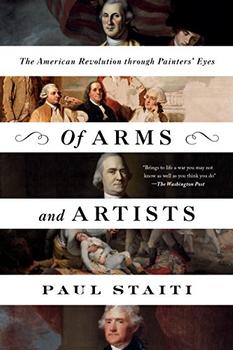Summary | Excerpt | Reviews | Beyond the Book | Readalikes | Genres & Themes | Author Bio

Critics' Opinion:
Readers' Opinion:
First Published:
Oct 2016, 400 pages
Paperback:
Sep 2017, 400 pages
 Book Reviewed by:
Book Reviewed by:
Emily-Jane Hills Orford
Buy This Book
1
Art and the American Revolution
Patriots in Revolutionary America were finally feeling optimistic in January of 1779. They had not forgotten the summer three years before when the British outmanned, outfought, and overwhelmed the Continental Army in New York, forcing General George Washington and his soldiers to flee, first to New Jersey and then to the banks of the Delaware River. They still had vivid memories of the invasion and occupation of Philadelphia, the capital city, in 1777, and the subsequent escape of the Second Continental Congress into the rural Pennsylvania countryside, followed by the wintering of Washington's army at Valley Forge, where unremitting disease, exposure, and malnutrition ravaged the soldiers, killing 2,500. In those years, America's future as an independent country was anything but auspicious.
But in 1778, history seemed to be turning in the Patriots' direction. Benjamin Franklin successfully persuaded France to forge a powerful military alliance committing the Versailles court to "make all the efforts in its Power" to uphold the liberty, sovereignty, and independence of the United States. That opened the doors to the formidable French army and navy, laden with troops, commanders, and cannons, as well as an ancient and active hatred of Britain. Fearing this new alliance would escalate the war into a global conflict, the British evacuated their stronghold in Philadelphia and hastily sent envoys to the Continental Congress to sue for peace. In June of 1778, Washington broke camp at Valley Forge and took back Philadelphia. In November, a freshly buoyant Congress rejected the British peace overture and declared that from then on any settlement of the war would have to be on America's terms.
Sensing the tide of war had shifted in the northern states, Pennsylvania passed a resolution on January 18, 1779, to honor "those who have rendered their country distinguished services, by preserving their resemblances in statues and paintings." This, the Supreme Executive Council added, was the sort of thing "the wisest, freest and bravest nations" do "in their most virtuous times." Seizing the moment, they appropriated money for a life-size, full-length portrait of Washington, the commander-in-chief, to be installed in the Council Chamber of the Pennsylvania State House, now Independence Hall.
The portrait—the first piece of public art in the United States— would be an enduring acknowledgment of "how much the liberty, safety and happiness of America in general, and of Pennsylvania in particular, is owing to His Excellency General WASHINGTON and the brave men under his command."1 It would stand as "a mark of the great respect which they bear to His Excellency," and as the Council made clear in its resolution, there was hope it would accelerate the American war effort by inspiring others "to tread in the same glorious and disinterested steps, which lead to publick happiness and private honour." Two days after the resolution was passed, Washington graciously assented to the Council's request to sit for a portrait and let it be known that their sentiments had made "the deepest impression on my mind."

Charles Willson Peale, Self-Portrait, 1777–78
The person to be entrusted with carrying out the commission was Charles Willson Peale of Philadelphia. Painter, militiaman, assemblyman, and ardent Patriot, Peale had impeccable credentials for the job, both as an artist and as a political and military man. He had not only fought at the Battle of Princeton in 1777, but also had visited Valley Forge, where he painted himself looking remarkably cheerful, given the hunger, disease, and despair afflicting the troops that winter. After Washington reclaimed Philadelphia in 1778, Peale was put in charge of identifying Loyalists in the city and then confiscating their estates, sometimes in a heartless way. He was so hated by some factions in the city that during the last two years of the war he had to walk through the streets with a cane made of seasoned ash, named Hercules, so that he could protect himself from assault.
Excerpted from Of Arms and Artists by Paul Staiti. Copyright © 2016 by Paul Staiti. Excerpted by permission of Bloomsbury USA. All rights reserved. No part of this excerpt may be reproduced or reprinted without permission in writing from the publisher.





The Flower Sisters
by Michelle Collins Anderson
From the new Fannie Flagg of the Ozarks, a richly-woven story of family, forgiveness, and reinvention.

The House on Biscayne Bay
by Chanel Cleeton
As death stalks a gothic mansion in Miami, the lives of two women intertwine as the past and present collide.

The Funeral Cryer by Wenyan Lu
Debut novelist Wenyan Lu brings us this witty yet profound story about one woman's midlife reawakening in contemporary rural China.
Your guide toexceptional books
BookBrowse seeks out and recommends the best in contemporary fiction and nonfiction—books that not only engage and entertain but also deepen our understanding of ourselves and the world around us.